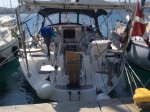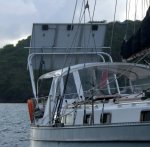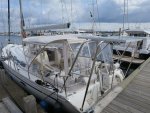Posse
New member
I am planning my solar panel installation on the targa arch, and would like your advice. The installation is intended for Atlantic/Pacific cruising.
To maximize area, I expect the panels to be mounted in the same orientation as the boat. On each side of the back stay I have just about 110 cm available.
This would allow 2x 100W panels side by side on each side of the arch, giving a total of 400W nominal power. The panels would "hang" about 45 cm in front and in back of the arch. Each panel measures 120x55 cm.
Or, I could put 1x 300w on each side, totalling 600W. They would "hang" about 65 cm in front and in back of the arch. Each panel measures 165x99 cm.
Of course, 600W would be better than 400W, but I am concerned about windage and stability in rough conditions.
Another concern is whether it is more practical to adjust the angle of four smaller panels, or two very large panels. And if the mounts will be able to hold the large ones angled in other than very calm conditions.
And last, if I needed do remove the panels for some reason (storm preparation?), the large ones would not go through the hatch to store below. The smaller panels would be relatively easy to stow away.
My boat is same model as the photo, and my arch will be very similar. Only, the panels would be oriented differently.

To maximize area, I expect the panels to be mounted in the same orientation as the boat. On each side of the back stay I have just about 110 cm available.
This would allow 2x 100W panels side by side on each side of the arch, giving a total of 400W nominal power. The panels would "hang" about 45 cm in front and in back of the arch. Each panel measures 120x55 cm.
Or, I could put 1x 300w on each side, totalling 600W. They would "hang" about 65 cm in front and in back of the arch. Each panel measures 165x99 cm.
Of course, 600W would be better than 400W, but I am concerned about windage and stability in rough conditions.
Another concern is whether it is more practical to adjust the angle of four smaller panels, or two very large panels. And if the mounts will be able to hold the large ones angled in other than very calm conditions.
And last, if I needed do remove the panels for some reason (storm preparation?), the large ones would not go through the hatch to store below. The smaller panels would be relatively easy to stow away.
My boat is same model as the photo, and my arch will be very similar. Only, the panels would be oriented differently.

Last edited:






